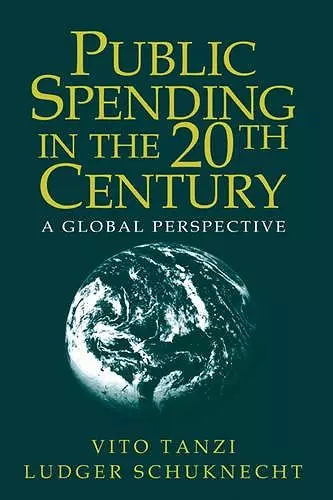Public Spending in the 20th Century
A Global Perspective
Vito Tanzi author Ludger Schuknecht author
Format:Hardback
Publisher:Cambridge University Press
Currently unavailable, and unfortunately no date known when it will be back
This hardback is available in another edition too:
- Paperback£39.99(9780521664103)

In this analysis of the increase in government spending across all industrialized countries, the authors find that the growth of the welfare state has not brought about much additional social and economic welfare. Could public spending be reduced without sacrificing policy objectives: the study provides a blueprint for policy reform.This book discusses the changing role of government finance in the twentieth century. It documents the enormous increase in government spending throughout the 1900s across all industrialized countries. However, the authors find that the growth of the welfare state over the past thirty-five years has not brought about much additional social and economic welfare. This suggests that public spending in industrialized countries could be much smaller than today without sacrificing important policy objectives. For this to happen, governments need to refocus their role on setting the 'rules of the game', and the study provides a blueprint for institutional and expenditure policy reform. After a detailed account of reform experiences in several countries and the public debate regarding government reform, the study closes with an outlook on the future role of the state, which is crucial in that globalization may require and people want much 'leaner' but not 'meaner' states.
' … a fascinating new book … Tanzi and Schuknecht argue, persuasively, that until the 1960s the rise in spending seems to have brought a big increase in public welfare, but that the extra spending mandated in the 1960s and 1970s, the age of greatest confidence in government, brought no further benefits.' Financial Times
'The authors argue that the state in most Western countries is far larger than it needs to be to achieve its economic or social objectives. Employing a simple, but logical, methodology, they make a surprisingly persuasive case that we have gained little or nothing in terms of improved economic or social (including redistributive) outcomes from the huge expansion of the state that took place after World War II. Moreover, they argue that it is not only desirable but feasible to reduce the share of the state from an average (for 17 OECD countries) of 46 percent of GDP in 1996 to something closer to the 28 percent that prevailed in the same countries in 1960. Although the arguments and conclusions of this book will no doubt be controversial, they cast important new light on the past and future of one of the most important phenomena of recent times - the growth of the state. The book should be read, and read widely.' Richard M. Bird, University of Toronto
'This excellent book documents the growth of government spending during the 20th century, its economic costs, and its disappointing failure in raising social welfare. Moreover, the authors - well-known public finance experts - argue convincingly in favor of government reduction, pointing out specific state reforms to reduce government size and raise social well-being. Although this brilliant volume is addressed to a general audience, it is rich in new statistical evidence and well grounded in modern theory. It should be mandatory reading for fiscal experts, policy makers, and the interested public at large.' Klaus Schmidt-Hebbel, Central Bank of Chile
'Widely regarded as the classic international study on the subject.' David B. Smith, Chief Economist, Williams de Broë
ISBN: 9780521662918
Dimensions: 229mm x 152mm x 21mm
Weight: 620g
308 pages